#Pdf From Web Form
Explore tagged Tumblr posts
Text
words for users !
ideias de palavras aleatórias para ajudar você a criar seu próprio user;
random ideas of words to help you to create your own user.

core -> aesthetic core
vlog -> daily videos
logs -> daily facts
mp3 -> audio file format
m4p -> apple audio file format
mp4 -> video file format
txt -> text format
jpeg -> image file format
jpg -> image file format
png -> image file format
gif -> animated file format
raw -> uncompressed file format
zip -> compressed archive file format
rar -> compressed archive file format
web -> internet file format
doc -> document file
pdf -> document file
vinyl -> phonograph record
film -> motion picture; photography
user -> person who utilizes a computer or network service
i2 -> "keeping it real"
self -> a person's essential being
itself -> a person's essential being
priv -> private
luv -> love's short form
tale -> a fictitious or true narrative or story
archive -> to place or store (something) in an archive
list -> connected items
tier -> a type of hierarchy
talk -> speak in order to express something
chat -> to have a conversation
post -> to announce or publish something
zone -> a subject to particular restrictions
vie -> life in french
tie -> to form a knot or bow in
on/online -> connected to a network
byte -> a group of binary digits
bits -> a small piece, part, or quantity of something
ram -> hardware in a computing device
8bit -> computer term used to designate either color depth
pixel -> a minute area of illumination on a display screen
data -> things known or assumed as facts
series -> a number of things, events, or people of a similar kind
village -> a self-contained community within a town or city
lab -> a laboratory
lady -> a woman
miss -> a form of address to a woman
mister -> a form of address to a man
error -> something not found
art -> the various branches of creative activity
petit -> small in french
poet -> a person possessing special powers of imagination or expression
thing -> an object without a specific name
stuff -> a vague reference to additional things
vogue -> the prevailing fashion or style at a particular time
tv -> taylor's version and/or television as a system or form of media
media -> the main means of mass communication
topia -> an imagined place or state of things in which everything is perfect
saur -> forming names of extinct reptiles such as dinosaurs
tune -> a melody, one that characterizes a particular piece of music
deun -> melody in deutsch
off/offline -> disconnected from the Internet
gloss -> shine or luster on a smooth surface
fae -> a fairy, in modern fantasy fiction
#random users#cute usernames#tumblr users#twitter users#usernames#user ideas#aesthetic usernames#soft users#users#aesthetic url#messycore#messy aesthetic#alt aesthetic#messy packs#aesthetic core#user#user name#random#random user ideas#random user#random ideas#text post#masterpost#masterlist#long post#long list
4K notes
·
View notes
Text
By Katherine Hamilton Digital Content Writing Fellow, RepresentUs June 1, 2021
Last election season, you probably saw a lot of social media posts and emails telling you to call your congress members and voice your support for certain issues.
But, does contacting your representatives really work?
The short answer? YES! You might be surprised to know just how much of a difference making a phone call or writing an email can be. Here’s why it works.
What happens when you call your representative?
When you call, your message is logged and relayed to your senator and the staffers in their office crafting policy. Every single call helps your senator know how much of a priority this issue is for their constituents. It’s all about building pressure, and calls are one of the most efficient ways to do so.
Four Reasons Calling Congress Makes a Huge Difference
Congress members care about re-election — and you control their chances. Congress members spend more than half their time in office focusing on re-election. If a politician wants to get re-elected, he or she has to ensure they’re addressing their constituents’ concerns. When you contact your lawmakers to let them know what policies you support, you’re telling them what they can do to win your vote in the next election. This is an extremely effective way of getting your officials to listen to you — and it’s exactly how democracy is supposed to work!
A lot of callers can build a lot of pressure. When a legislator starts hearing the same concerns from a lot of citizens, it puts a lot of pressure on them to vote the way their constituents want. Flooding a lawmaker’s inbox or phone line can completely stall office activity, and really get the attention of your elected official. When you contact your representative, you’re adding your voice to a wave of grassroots pressure.
It’s one of the best ways to voice your opinion in the election off-season. There’s not always an election around the corner, and even when there is, you don’t always get to vote on the issues you really care about. But civic participation can — and should — happen year-round. Contacting your elected officials holds them accountable for representing you, even when it’s not election season.
It literally only takes two minutes! One of the best things about calling your representatives? It’s incredibly quick and easy to do. Most groups that ask you to contact Congress will provide you with easy-to-follow instructions and a simple script to read — although adding personal touches is highly encouraged! Who knew saving democracy could take as much time as brushing your teeth?
All questions and comments regarding public policy issues, legislation, or requests for personal assistance should be directed to the senators from your state. Please be aware that as a matter of professional courtesy, many senators will acknowledge, but not respond to, a message from another senator's constituent.
Options for Contacting Senators
Web contact forms are available on most senators' websites
Postal Addresses
Addresses for each senator can be found on the senator's website or state's web page
The following standard address can be also be used: The Honorable (Name) United States Senate Washington, DC 20510 For correspondence to a Senate committee or to a Senate committee chair: (Name of Committee) United States Senate Washington, DC 20510
Telephone
Phone numbers are available on each state's page or on your senator's website
Senators Suite & Telephone List (PDF)
A U.S. Capitol Switchboard operator can also connect you directly with the Senate office. (202) 224-3121
244 notes
·
View notes
Text
African Social Spiders: these spiders live in colonies that can contain up to 2,000 spiders, most of which are female; they hunt, forage, maintain their web, and raise their offspring as a group, without any dominance hierarchy or caste system
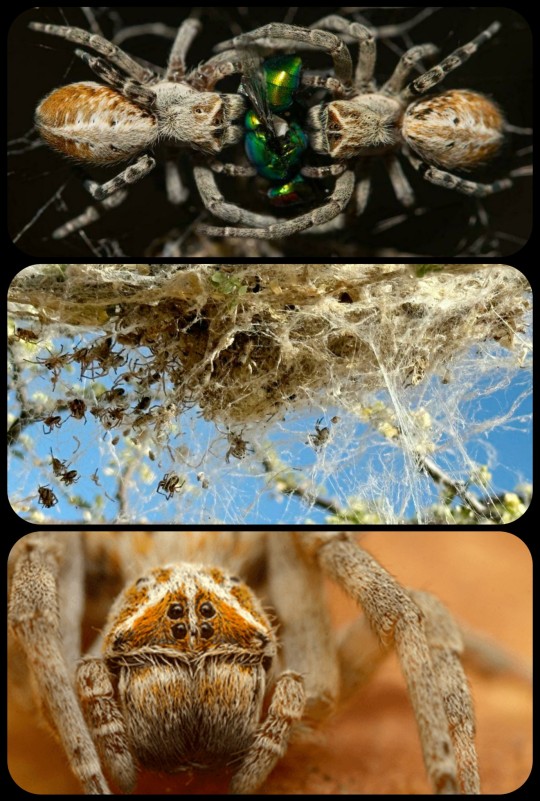
This communal behavior is extremely rare among spiders, which are normally solitary creatures. The African social spider (Stegodyphus dumicola) is one of the few species that has been identified as a true "social spider," forming colonies and living in communal nests where the spiders work together to hunt, forage, build webs, and care for their offspring.
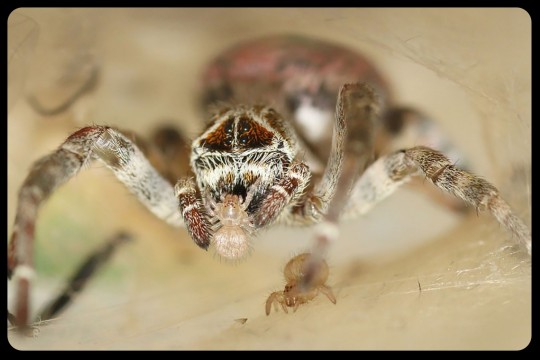
Above: an African social spider feeding the young spiderlings of her colony by regurgitating food for them, exhibiting a level of maternal/allomaternal care that is relatively uncommon in both spiders and insects
African social spiders can be found in various parts of southwestern Africa, where they will often build a dense silk nest in the branches of a thorn tree and/or shrub. Most of the spiders in the colony are female (more than 85%, according to some studies) and the species itself also has a female-biased primary sex ratio, as researchers have found that female embryos develop in more than 80% of the eggs that the spiders produce.
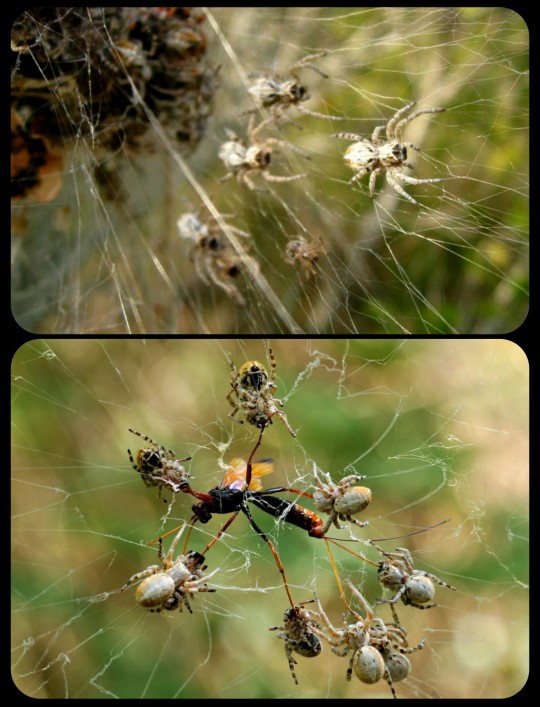
Above: a group of African social spiders working together to subdue their prey, which will be taken back to the nest so that it can be shared with the rest of the colony
There is no evidence that any dominance hierarchy or caste system exists within S. dumicola colonies. The spiders all cooperate to complete a variety of tasks, such as hunting, repairing the web, foraging, defending the colony, caring for the colony's offspring, etc. While none of them are exclusively assigned to a single task, many have a primary role that they fill, often based on their physical size and condition.
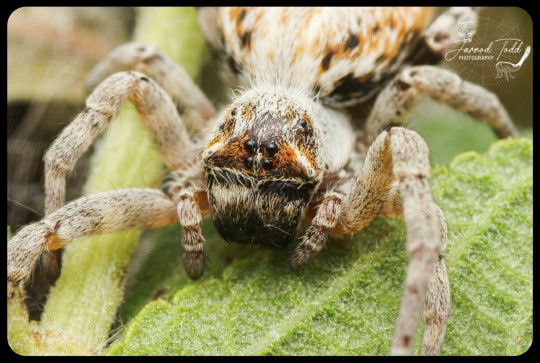
Above: close-up photo of S. dumicola
This species also engages in extreme allomaternal care, meaning that many different spiders (including both mothers and "allomothers") all share the responsibility of caring for the colony's offspring; even the unmated females help out with brood care. The mothers/allomothers tend to the eggsacs, regurgitate food for the baby spiderlings, and even engage in matriphagy, which means that they will eventually be cannibalized by the babies.
From The Encyclopedia of Animal Behavior:
... some proportion of females do not reproduce – sometimes as much as 60% – but remain as helpers, contributing to foraging and brood care (allo-mothering). Both breeding females and virgin allo-mothers regurgitate food for colony offspring and eventually let the young consume their bodies. ...
Young that are raised with both mothers and allo-mothers show higher survival and growth than young raised by their mothers alone, suggesting a clear fitness benefit of cooperative breeding.

Spiders of this species generally measure about 2.5 - 3.5mm long; they can be found in Namibia, Botswana, Zimbabwe, South Africa, Lesotho, and Eswatini.
Sources & More Info:
Science Direct: Social Spiders
Current Biology: Quick Guide to Social Spiders (PDF)
Phys.org: Untangling the Social Lives of Spiders
Proceedings of the Royal Society B: The Age & Evolution of Sociality in Stegodyphus Spiders
Entomology Today: Social Spiders Divide Labor According to Body Size & Condition
Animal Behaviour: Extreme Allomaternal Care by Unmated Females in a Cooperatively Breeding Spider
National Geographic: Baby Spiders Eat their Mothers
University of Portsmouth: Social Spiders Have Different Ways of Hunting in Groups
Behavioral Ecology: Spider Societies Mitigate Risk by Prioritizing Caution
Behavioral Processes: Warring Arthropod Societies
Behavioral Ecology and Sociobiology: Does the African Social Spider Stegodyphus dumicola Control the Sex of Individual Offspring?
#arachnology#spiders#african social spiders#stegodyphus#dumicola#arthropods#arachnids#allomaternal#matriphagy#communal spiders#social spiders#cool bugs#animal facts#tw arachnophobia#cw spiders#anarcho-feminism?#more like arachno-feminism#just a bunch of radfem commie cannibals
264 notes
·
View notes
Text

James Collier has a new comic coming out soon, and he was kind enough to send me a little PDF of it. It's great, I liked it a lot. Collier has a few influences which feel very prominent - Connor Willumsen, Sammy Harkham, Antoine Cosse - all cartoonists I like, but in a way they almost feel like the "correct" influences for a young cartoonist to have, in a way I'm skeptical of. A language is being used which is immediately appealing, and I become skeptical of it because I feel like there should be SOME friction between the surface and my eyes, which can generate some unexpected effect. I like it, I recognize it as good, but I want something to sneak up on me. Of course, what sneaks up on me is the development of Collier as an artist. While his previous book, The Lonesome Shepherd, was in black and white, Ballpark is mostly in color, and mostly in six-panel grid form. Each panel has a great use of flat color to separate foreground from background, and Collier is continually moving his appealing-looking cartoon characters through space, making for really fun pages. His cats and dogs recall Fritz The Cat, but we're in a post-Crumb, post-Bakshi space: If underground sordidness felt like a subversion of classic cartoon funny animals, Collier occupies a world where weed is legal, edibles can be taken in gummi candy, and when we hang out, whether we occupy a stoned or sober mindset is largely irrelevant, if we can enjoy each other's company, the world around us is beautiful either way.
This comic is funny, I laughed out loud. As per the drug comparison, trying to locate the register on the irony-sincere continuum is a fool's errand. These are dogs and cats, cartoon animals. These are pleasurable now in the same way as they've been throughout comics history. They don't situate themselves in terms of the "relatable" as a sort of lowest-common-denominator way for the reader to find their way into the work, but rather stay recognizable as cartoon forms that the reader doesn't need to identify with in order to understand.
Check it out, I think you'll like it. Like The Lonesome Shepherd, it's being published by the Wig Shop Web Shop; copies of that earlier comic should still be available.
26 notes
·
View notes
Text
Official Submission Rules and Guidelines
Please be sure to look over all of the submission guidelines if you are planning on submitting work to the journal.
Type of work allowed
We are looking for well crafted fanart, fanfiction, fanscripts, web weavings, theories, analyses, or critiques of the show that showcase thought provoking and unique ideas within the fandom, promoting healthy conversation and debate and pushing the boundaries of fan creations. If you have a piece of work that you would like to submit but does not fit into any of the previously listed categories, please DM the fandom journal tumblr account, send an ask, or email us.
Maximum of 3 entries per person
This helps create less work for our team, but also helps the journal feel balanced and fair, rather than being taken up by one creator.
We will not accept work made before 2022
You will not need to make anything new for the journal, however we do ask that all work submitted be made during or after 2022. This is to ensure that the work within the journal is up to date on the show and is a commentary and reflection of relevant information.
Collaborations are allowed, but this will count as an entry for each creator involved
For example, you cannot submit three solo works and then one collaboration, but you can post two solo works and one collaboration. Only one collaborator needs to submit this work, but must include bios for each person involved. We understand that sometimes with theory or analysis posts, other creators will occasionally be cited or linked. This does not count as a collaboration, and will not take up one of their submission spots.
Work must focus on Mike and/or Will and should be made through a Byler lens
Since this is a Byler fandom journal, I would like to keep the work Byler related in order to keep it cohesive. The work does not need to focus solely on their relationship, and can focus on just Mike or Will and include other characters, but should be at least through the lens of Byler. For example, you could submit an analysis that is solely about Mike, as long as it is made through the understanding that his story arc will lead him to be with Will in the end. Work will be evaluated on a case-by-case basis for relevancy.
Dark/sensitive work will receive a content warning label
Since our goal with the journal is to share work that promotes unique ideas and debate, we will not be barring work that includes discussion or depiction of content that is considered dark or sensitive. However, if these works are selected, they will be presented along with a content warning label. The journal team will decide which works receive this label and what warnings to include.
We will not accept work that targets another creator
With this journal, we aim to showcase a healthy conversation within the fandom, which oftentimes include different viewpoints and opinions. However, we will not condone any work/posts that intend to target another creator to harass or disparage them. We understand that with theory/analysis work, some posts are made that aim to argue against a general idea within the fandom. These posts are acceptable, so long as they do not single out any individuals.
You may not submit on another creators behalf
The only work that is submitted should be your own, or a collaboration between you and another creator. You may not submit work that was created entirely by someone else. If you are submitting a collaboration, please be sure that you have consent from all other artists involved.
Moving image work is not allowed
The final version of this journal will be published in the form of an online PDF. As such, moving images such as video edits and gifs are not allowed, as the format we are using cannot support this type of work.
No work is guaranteed to be selected
We aim to create a cohesive journal of work that is well crafted, thought provoking, and unique. If we feel that a work does not belong in our journal, we are entitled to reject it. Do not feel that a rejection is a reflection of your skill as a creator. Your work may just not be what we are looking for right now.
Please be patient!
This is the first run of the journal, so we expect that there will be things we will be learning along the way. Since this is a small time working in their free time, the turnaround for the final product will take some time, and while we can give a loose framework for when we believe the final journal will be available, we will not have a definitive date until later in the process. We thank you for your patience.
Submission Guidelines
Each work that is accepted will be formatted by our editors in a way we believe supports the integrity of the work. For written work, we will proofread for any spelling errors. Proofs will be sent to the original creator to be approved before going into the final journal. We will accept any edits the creator would like to make, within reason. Please include a title for each work, even if not originally titled.
Fanfiction: One-shots, single chapters or excerpts only, with a maximum of ~3,000 words. If you have a few short chapters of a fanfiction you would like to edit into a single chapter, this is acceptable so long as it stays within the word limit. The work submitted should be able to stand on its own. Please submit a link to the tumblr/ao3 respective work or upload a google doc. If this work is accompanied by any illustrations, please upload files for the images separately.
Fanart: Link to your original post, as well as a high quality upload of your artwork in .jpg or .png format. Be sure to include a title for your piece.
Comics/multi-page art: You may submit comics or other multipage art pieces with a maximum of 5 pages, or be able to be formatted into 5 pages. If you have any questions about if your work would qualify, please reach out to us via email or in DMs.
Fanscripts: Similar to comics, these should be a maximum of 5 pages. The text from the scripts will be transcribed onto the page.
Web Weavings: Web weavings are in a unique category of fan creation, but we would still like to open our journal to these works. We are looking for web weavings that are able to format neatly onto one or two pages. We recommend transferring the images from the web weaving onto a google doc.
Theories/Analyses/Critiques: These entries are limited to ~5,000 words. If the original is too long, or you would like to edit or change part of the original post, you may move it into a google document and upload it that way. If the post was made answering an ask, please be sure to include the original question and who asked it, as these will be included in the journal.
Note about external links: We understand that theories, analyses, or any other post may include links to other posts or outside sources. Luckily, the online PDF format is able to support these types of links, so we will be able to include them within the journal.
Note about screenshots: We know that with analyses and theories, screenshots are often used. For the purpose of design and formatting, the original screenshots in your post may be replaced with higher quality screenshots, although we will try to keep the message and integrity of your original work intact. We also advise against work that relies too heavily on screenshots over words, as these will be difficult to format in the journal. All theories, critiques and analyses should be text based and use images to supplement the text.
Submissions open November 1st and close January 17th
The limited submission window is to give our team enough time to sort through submissions and make selections before we begin the design process. A google form will be created and linked in our bio for submissions.
32 notes
·
View notes
Text
Are Game Blogs Uniquely Lost?
All this started with my looking for the old devlog of Storyteller. I know at some point it was linked from the blogroll on the Braid devlog. Then I tried to look at on old devlog of another game that is still available. The domain for Storyteller is still active. The devblog is gone.
I tried an old bookmark from an old PC (5 PCs ago, I think). It was a web site linked to pixel art and programming tutorials. Instead of linking to the pages directly, some links link led to a twitter threads by authors that collected their work posted on different sites. Some twitter threads are gone because the users were were suspended, or had deleted their accounts voluntarily. Others had deleted old tweets. There was no archive. I have often seen links accompanied by "Here's a thread where $AUTHOR lists all his writing on $TOPIC". I wonder if the sites are still there, and only the tweets are gone.
A lot of "games studies" around 2010 happened on blogs, not in journals. Games studies was online-first, HTML-first, with trackbacks, tags, RSS and comment sections. The work that was published in PDF form in journals and conference proceedings is still there. The blogs are gone. The comment sections are gone. Kill screen daily is gone.
I followed a link from critical-distance.com to a blog post. That blog is gone. The domain is for sale. In the Wayback Machine, I found the link. It pointed to the comment section of another blog. The other blog has removed its comment sections and excluded itself from the Wayback Machine.
I wonder if games stuff is uniquely lost. Many links to game reviews at big sites lead to "page not found", but when I search the game's name, I can find the review from back in 2004. The content is still there, the content management systems have been changed multiple times.
At least my favourite tumblr about game design has been saved in the Wayback Machine: Game Design Tips.
To make my point I could list more sites, more links, 404 but archived, or completely lost, but when I look at small sites, personal sites, blogs, or even forums, I wonder if this is just confirmation bias. There must be all this other content, all these other blogs and personal sites. I don't know about tutorials for knitting, travel blogs, stamp collecting, or recipe blogs. I usually save a print version of recipes to my Download folder.
Another big community is fan fiction. They are like modding, but for books, I think. I don't know if a lot of fan fiction is lost to bit rot and link rot either. What is on AO3 will probably endure, but a lot might have gone missing when communities fandom moved from livejournal to tumblr to twitter, or when blogs moved from Wordpress to Medium to Substack.
I have identified some risk factors:
Personal home pages made from static HTML can stay up for while if the owner meticulously catalogues and links to all their writing on other sites, and if the site covers a variety of interests and topics.
Personal blogs or content management systems are likely to lose content in a software upgrade or migration to a different host.
Writing is more likely to me lost when it's for-pay writing for a smaller for-profit outlet.
A cause for sudden "mass extinction" of content is the move between social networks, or the death of a whole platform. Links to MySpace, Google+, Diaspora, and LiveJournal give me mostly or entirely 404 pages.
In the gaming space, career changes or business closures often mean old content gets deleted. If an indie game is wildly successful, the intellectual property might ge acquired. If it flops, the domain will lapse. When development is finished, maybe the devlog is deleted. When somebody reviews games at first on Steam, then on a blog, and then for a big gaming mag, the Steam reviews might stay up, but the personal site is much more likely to get cleaned up. The same goes for blogging in general, and academia. The most stable kind of content is after hours hobbyist writing by somebody who has a stable and high-paying job outside of media, academia, or journalism.
The biggest risk factor for targeted deletion is controversy. Controversial, highly-discussed and disseminated posts are more likely to be deleted than purely informative ones, and their deletion is more likely to be noticed. If somebody starts a discussion, and then later there are hundreds of links all pointing back to the start, the deletion will hurt more and be more noticeable. The most at-risk posts are those that are supposed to be controversial within a small group, but go viral outside it, or the posts that are controversial within a small group, but then the author says something about politics that draws the attention of the Internet at large to their other writings.
The second biggest risk factor for deletion is probably usefulness combined with hosting costs. This could also be the streetlight effect at work, like in the paragraph above, but the more traffic something gets, the higher the hosting costs. Certain types of content are either hard to monetise, and cost a lot of money, or they can be monetised, so the free version is deliberately deleted.
The more tech-savvy users are, the more likely they are to link between different sites, abandon a blogging platform or social network for the next thing, try to consolidate their writings by deleting their old stuff and setting up their own site, only to let the domain lapse. The more tech-savvy users are, the more likely they are to mess with the HTML of their templates or try out different blogging software.
If content is spread between multiple sites, or if links link to social network posts that link to blog post with a comment that links to a reddit comment that links to a geocities page, any link could break. If content is consolidated in a forum, maybe Archive team could save all of it with some advance notice.
All this could mean that indie games/game design theory/pixel art resources are uniquely lost, and games studies/theory of games criticism/literary criticism applied to games are especially affected by link rot. The semi-professional, semi-hobbyist indie dev, the writer straddling the line between academic and reviewer, they seem the most affected. Artists who start out just doodling and posting their work, who then get hired to work on a game, their posts are deleted. GameFAQs stay online, Steam reviews stay online, but dev logs, forums and blog comment sections are lost.
Or maybe it's only confirmation bias. If I was into restoring old cars, or knitting, or collecting stamps, or any other thing I'd think that particular community is uniquely affected by link rot, and I'd have the bookmarks to prove it.
Figuring this out is important if we want to make predictions about the future of the small web, and about the viability of different efforts to get more people to contribute. We can't figure it out now, because we can't measure the ground truth of web sites that are already gone. Right now, the small web is mostly about the small web, not about stamp collecting or knitting. If we really manage to revitalise the small web, will it be like the small web of today except bigger, the web-1.0 of old, or will certain topics and communities be lost again?
60 notes
·
View notes
Text
so, my friend @thing-in-the-yellow-mask and I recently realized that the descriptions of the creatures from the beastiary in part 17 match up almost perfectly with descriptions in the Call of Cthulhu sourcebook H.P. Lovecraft's Dreamlands: Roleplaying Beyond the Veil of Sleep, and after spending a minute hunting down a pdf of it, we found that almost every creature in the show has an entry and description, so boy do I have some interesting things to share with y'all. More under the cut
Lamp-Eft
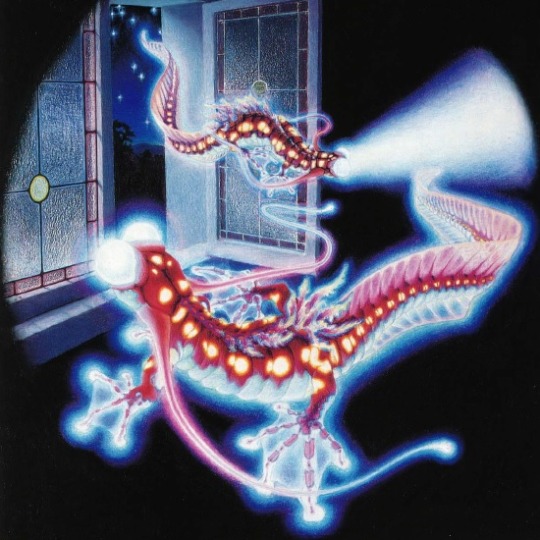
"A lamp-eft is a salamander-like creature two or three feet long. It floats in the air, writhing its way along with its flattened tail and four paws, but has no wings. It has two huge globe-like eyes, but no mouth. Lamp-efts normally inhabit the upper air, and only descend to the earth’s surface at night. They feed on ambient magic. Lamp-efts are easily tamed and magicians sometimes use them as a live-in defense against shades. lamp-eft can project a beam of bright colorless light toward a target."
Zoog

"Zoogs are small and brown, with a rodent-like body outline. Small tentacles dangle from their snouts, concealing their small sharp teeth. Zoogs live in burrows and tree-trunks in the Enchanted Wood. There are several prominent zoog villages in their domain. Though they live mostly on fungi, zoogs have a taste for either spiritual or physical meat as well, for many dreamers have entered their wood and failed to return."
Boltworm of the Bnazic Desert

"Closely related to the fireworm is the boltworm. Boltworms are found primarily in the Bnazic Desert, but have been sighted in other desert areas throughout the Dreamlands. During its travels the boltworm builds up an enormous static charge which it can release at prey or attackers either to stun or kill. Once every decade or so, the boltworms release great amounts of this energy during their courtship and fill the skies with sheet lightning."
Gug
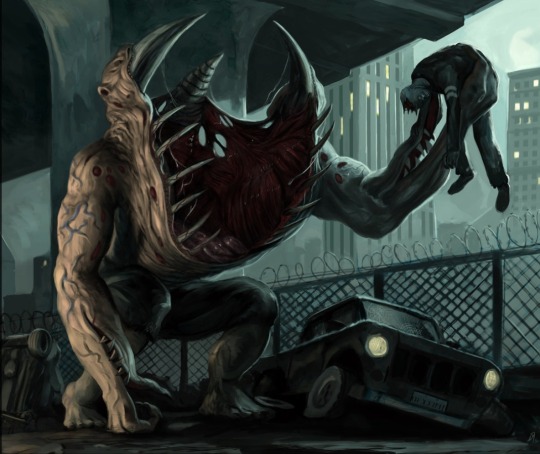
"The Gugs are a hairy and gigantic race of beings which once inhabited the surface of the Dreamlands in the area where the Enchanted Wood now stands. Here they reared a circle of colossal stones and made sacrifices to the Other Gods and the crawling chaos, Nyarlathotep. Finally, while trying to summon Yog-Sothoth into the Dreamlands, the Great Ones took notice of their blasphemies and banished them to the Underworld forever. Only a great trap door at the top of the tallest tower in their city, the Tower of Koth, connects their realm with the surface world, but no Gug will dare to open that door for fear of the curse of the Great Ones. Gugs stand approximately 20 feet in height and are covered by a coat of short, coarse hairs. Roughly humanoid in form, their arms split into two separate and fully functional forearms at their elbows; in effect giving them four arms and paw-like hands. It is the gugs’ head which is their most striking feature. Their mouths are filled with great yellow fangs and run vertically from their foreheads to their chins. Their pink eyes, set on either side of their head, bulge outward and are shaded by bony protuberances. Their ears are so small as to be non-existent, but they have a highly developed sense of hearing and they can pick up even the slightest sound. Gugs are also capable of moving almost as silently as nightgaunts. Combined with the fact that they have become accustomed to seeing in absolute darkness, this means that they can strike without warning at any who may blunder around in the dark."
Haemophore
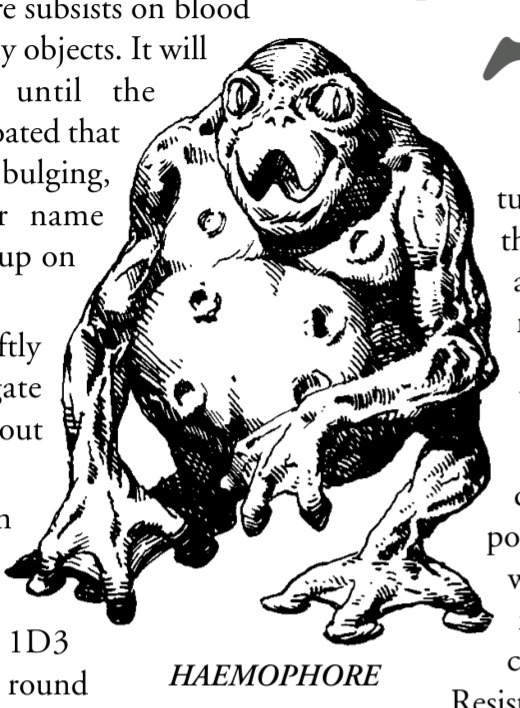
"Haemophores are small humanoid beings with webbed hands and feet, and curious W-shaped mouths. A haemophore subsists on blood and is attracted to bright and shiny objects. It will suck blood from a victim until the haemophore is so monstrously bloated that it is completely distorted and bulging, incapable of movement. Their name comes from their habit of filling up on blood before migrating. Haemophores move very softly and often carefully investigate potential prey before sucking out blood. Once a haemophore has bitten a target, the creature remains attached on subsequent rounds, sucking blood and draining 1D3 points of the victim’s STR each round until the victim dies. If the victim survives, the STR returns at a rate of one point a day"
Buopoth/Lily
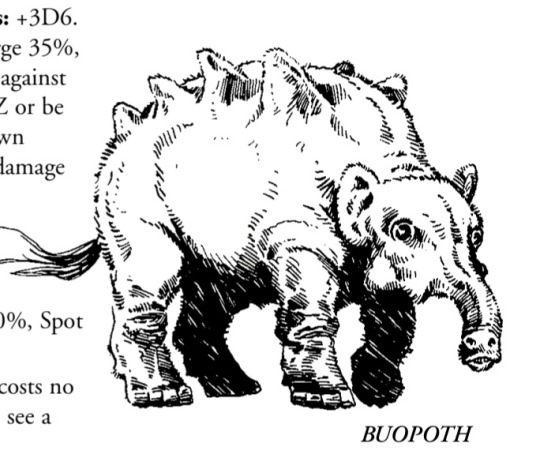
"Buopoths are a little larger than horses, but resemble elephants in general outline. Buopoths are pale mauve, with light green mottling over the backs and sides. The skin is soft and felt-like, and the mouth is at the end of a long trunk-like proboscis. The ears are shaped more like human than elephant ears. Along each side of the back are rows of protuberances. Their eyes are large and liquid. Their calls are soft and melodious trumpetings. Buopoths live in remote forested areas. They are gentle and skittish creatures which would rather flee than fight. If cornered, a buopoth rolls up its proboscis to keep it out of danger and charges, trying to knock down and trample its opponent."
#there was. a LOT more on gugs so if anybody wants it hit me up#there's a lot of other stuff in this book that i find extremely interesting relating to mostly nyarlathotep#but i might make another post about that stuff cuz this one is already extremely long#also i included the extra gameplay stuff on the haemophore because i felt it was important to its actual behavior#malevolent podcast#malevolent#ted.txt
176 notes
·
View notes
Text
A friend just reminded me of an old concept of mine I still like a lot, my take on urban fantasy. (01/2022)


In the modern age, paranormal menaces are starting to adapt to the new technologies.
What are the new generations going to do when they receive threatening dms from a creepy pasta, their console gets possessed by a vengeful spirit, or a tricky ghost hides the last draft of their thesis?
Why, call "Nati and Tina, Paranormal IT", of course!
Martina is a sheltered and smart 18 yo who loves computers more than anything. She comes from a family of eccentric ghost hunters, but doesn't want to follow in on their footsteps.
Natalia is a messy and extroverted 23 yo with an interest in witchcraft and the paranormal. IT is her third try at superior studies after dipping her toes at marketing and business.
Together they form a Paranormal IT side hustle combining their strenghts. Nati needs the money, and Martina is enchanted by the cool girl who wants to hang out with her, even if she wanted to distance herself from ghost stuff.


The E-Cronomicon, Nati's E-Book. It's so full of occult lore pdfs from the dark web it's become cursed. - Using necromancy to get back the soul of an accidentaly deleted thesis project.

At the library researching a case, Nati with boba tea, Martina with way too many energy trinks. - They live in the city (either Barcelona or a made up one inspired by it), so their company ride is the bus. Here they're securing a cursed TV.
So yeah, haven't thought about this in a while but I like the concept a lot. I barely have broad strokes and ideas of what the history and structure would be.
Nati's design needs a bit of a retouch, I think I want her to be cool and fashionable, but I am incapable of drawing something I have no idea about. Martina's is perfect, one of my favourite designs I've done.
#character design#worldbuilding#urban fantasy#ghost hunting#paranormal#paranormal investigation#original character#original charater art
11 notes
·
View notes
Text
Hello Whitechapel,
Welcome to Revamped, a My Babysitter’s a Vampire fan-project led by a group of three young adults. You can call us Evellow! This account is dedicated to the revival project for the beloved childhood Canadian classic, and we would love to have you join us in the development and release of the series.
How is the series going to be formatted though? Well, after some deliberation between whether or not it should be uploaded via AO3 in classic fan-fiction format, or written in screen-write format to truly emulate the feeling of it being a show, we’ve gone with screen-write style. It is not, however, an actual multi-media or web series.
We currently aim to upload each episode script on here in google doc PDF form, though we are open to other platform options if requested and given time to think through.
This is a completely non-profit project, and we are unaffiliated with any professional individuals involved in the making of My Babysitter’s a Vampire. This is nothing more than something fun for us to do, similar to that of a fanfiction.
While you will of course recognize all the familiar ‘faces’—or rather names, of the well-adored main characters and some similar plot lines, we look forward to you hopefully welcoming a select few new characters and plot developments in this queer-friendly, amp-up-the-horror retelling of the show.
As we work towards the release of the pilot script, keep an eye out for fun creations from our team such as photo edits, “cast” releases, short stories, fanfics (inception?), and more.
Fangs out!
#my babysitter's a vampire#my babysitter’s a vampire: revamped#revamped#MBAV#mbav revamped#Ethan Morgan#Sarah Fox#Benny Weir#Rory Keaner#Erica Jones
58 notes
·
View notes
Text
We found a new antibiotic target in bacteria!!
It took almost 4 years, but the fruits of my postdoc research are finally here! In our paper (with me as the first author), just published in Nature Communications, we decipher a working mechanism of an antibiotic that targets the membrane of bacteria in an unprecedented way!
enhanced PDF: https://rdcu.be/dgj2d web version: https://lnkd.in/eRpxr4jg

And how does it work?
The antibiotic AMC-109 first self-assembles into stable aggregates with a cationic surface. These aggregates then specifically target bacteria cells and insert into their membrane.
You can see the process how we simulated it in a computer on the figure below. Grey-Blue is the antibiotic, Red-Yellow are lipids that together form a membrane.
@jmelcr did this awesome simulation work! You are an amazing scientist, jmelcr! I love you and it seems our collaboration did not ruin our marriage. Not yet, anyway 😄.
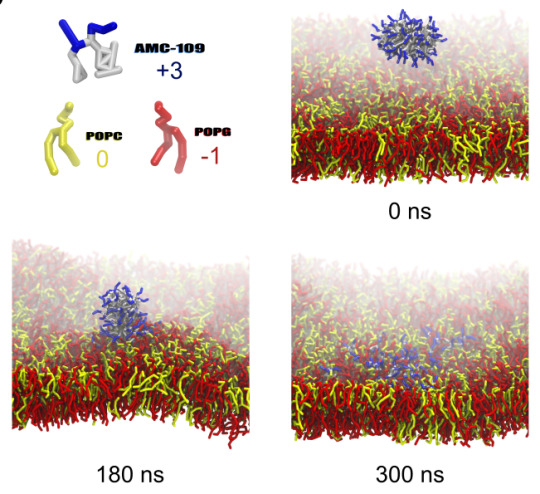
After insertion into the bacterial membrane, the antibiotic dissolves membrane nanodomains affecting membrane function without formation of any pores or holes in the membrane.
Below is the series of high-speed atomic force microscopy images that shows the process of dissolution of membrane nanodomains. Yellow are the membranes extracted from bacteria laying flat on a hard surface (black). The membranes contain nanodomains (bright yellow) that are important in living bacteria for its survival. Addition of antibiotic dissolves them.

More studies will follow that use this new target in bacteria giving us an advantage over untreatable superbugs. I will keep you posted. And... keep your fingers crossed. It's research after all, so we never know if and how well it's going to work.
#science#women in science#research#postdoc#stem#biophysics#antimicrobial#antibiotic#amr#achievement#scientific journals#publication#breakthrough#original content
55 notes
·
View notes
Text
IT'S APRIL 14TH. THERE GOES JANUS TO BE BURIED ALIVE.
thank you to @fangirlwriting-stories and @lifewithoutrainydays for betaing this monster and/or egging me on! My love for Greek theatre, Greek tragedies, absurdist theatre, terrible puns, and pointed character studies have all combined into this: the Antigone AU, 13k of dialogue, monologue, and Remus waxing less-than-poetic about whatever the hell he wants. Is it an AU? Is it canon? Is it plausible to perform onstage? We just don't know.
the prologue/semi-explanation for what I'm doing (in poem form, what??) can be found here: the task of the translation. If you're curious about all of the other translations of Antigone I referenced, links to them can be found under the cut!
Brief, simple overview of Antigone's scenes and structure: here, if you want to get an idea of what's going on but don't want to read the full play.
Antigonick by Anne Carson: plain-text pdf (contains the original 'task of the translator' as a prologue), illustrated pdf, readthrough ft Anne Carson (read in English, despite the Swedish intro. Definitely a strange production, and not for everyone)
Antigone trans. Don Taylor: pdf, stage production by National Theatre (starring Jodie Whittaker and Chris Eccleston. costs about $11 to rent, but well worth it), interviews with cast and clips from that show (Youtube, free)
Antigone trans. Paul Woodruff: pdf
#jantigone#sanders sides fanfiction#my writing#janus sanders#roman sanders#remus sanders#the others are there too but those three really are the main characters in this#antigonick
20 notes
·
View notes
Text











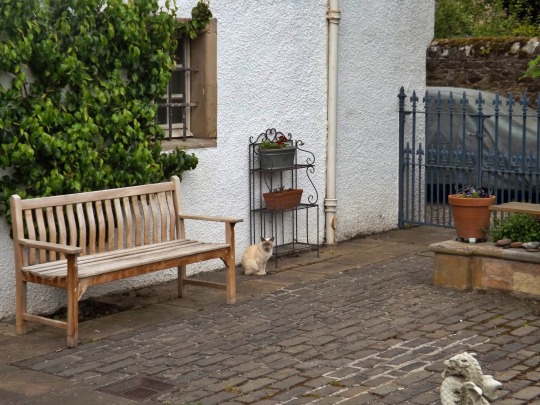



Nofrthfield House, Prestonpans.
As I said in the last post about Hamilton House, it wasn't the oldest property in this historic part of "The Pans" Check the lintel in the second pic, it reads 1611- but, this house in some form was around a bit earlier than this, in 1607 it was sold by The Hamiltons, to Joseph Marjoribanks, a burgess of Edinburgh. Marjorybanks extended and "embellished" the house, and this work was finished on the date above the door. Around 1700 it was sold and has went through a number of owners through the centuries, but has been occupied, apart from a short period around the turn of the 21st century constantly for over 400 years. Northfield House was put on the market in 2019 for a cool £1 million. I can't see if it has actually been sold as yet, but it is no longer on the estate agents web page. Savills, who marketed as a “historic family home” of “immense character”, with “intricate period detail” and “excellent potential for a self-contained granny or staff flat”. The current owners have renovated Northfield House over the past 18 years, which included rebuilding the chimney stacks, overhauling the roof and lead where required, repairing the harling and repainting and replacing the gutters and downpipes. The house has, a Hallway, Drawing Room, Dining Room, 7 Bedrooms, Studio, 2 Bathrooms, 2 WCs, Utility Room, Family Kitchen. Cloakroom/Original kitchen, Cellar, 2 Store Rooms, Old Kitchen, Garden Room and a Coach House. I know you will all be dying to have a wee look inside, well hit the link and enjoy https://assets.savills.com/properties/GBEDSCEDT170135/EDT170135_EDT18000795.PDF
50 notes
·
View notes
Text

-ˋˏ ༻✿༺ ˎˊ-
General Information
What is a fanzine?
A fanzine is an unofficial publication of illustrations and writing by fans of a subject for the enjoyment of other fans.
How will this zine be published?
This zine will be published as a free digital pdf. It will be formatted for ease of physical printing at a fans own discretion.
What will be the contents of this zine?
Bdubszine will contain all things Bdubs, that’s the theme! It will contain illustrations, writing, and any other creative media about Bdubs, from any series.
What is considered other media?
Other media is any other art form other than illustrations and writing that can depict Bdubs in a pdf page format. This includes but is not limited to: cosplay, renders, ect. This does not include transformative works and moving works such as web weaves, collages, and animation. Since this is a broad category, feel free to ask before submission if this includes your medium of choice.
Who is hosting this zine?
meeeee ! ! !!! <3 hi its me cutepluto hi!!!
and also beau is helping
-ˋˏ ༻✿༺ ˎˊ-
Contributor Information
How many contributors will be accepted?
We hope to accept everyone, but there is a hard limit of 40 contributors. No specific ratio of artist, writer, and other will be accepted.
How will contributors be contacted on information?
Contributors will be contacted on tumblr for the results of acceptance and rejection, or other methods listed in the form. After that, all contributors will be asked to join a discord and will be informed of updates there, as well as be asked for check-ins there.
Can contributors post their work?
During the creation period, contributors can post their pieces in small preview portions and wips, but not post the full work until after the zine is released. To keep it all a fun surprise! After the zine is posted, works are free to be posted however wanted.
-ˋˏ ༻✿༺ ˎˊ-
Creation Information
What is the limit for what can be drawn?
This zine is strictly sfw. No nsfw or suggestive works will be allowed. Violence and blood permitted but go easy on it.
Is shipping allowed?
Shipping is allowed for the character Bdubs, but heed the sfw limits. Additionally, Bdubs should still be kept as the main focus within the work.
Are headcanons allowed?
Of course, this is hermitblr after all. Keep headcanons to the point of retaining recognizablility of characters and it will be allowed.
Can non-canon events be in the creation?
Yes, but no canon divergence or straight up aus.
-ˋˏ ༻✿༺ ˎˊ-
Applications open July 9th. Interested? Still have questions? Make sure to check out the blog. Thank you, love ya to death.
22 notes
·
View notes
Text
i did brown puzzlehunt 2024 (link!) with members of test solution bees ignore! the automated tools in their spreadsheet template kept pushing my pre-hunt drawing backward so that people couldn't see it upon opening our sheet
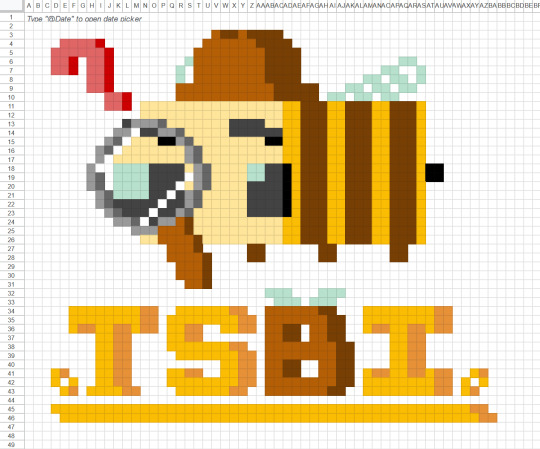
(full disclosure, this was referenced from another artist's work - can't take full credit for it)
bph24 was a really wide hunt with lots of small rounds, featuring tons of top-notch art and non-static presentation. i liked it a lot! it just wasn't really a single-weekend sort of hunt, so our team of 4 didn't finish before the event ended lol
solutions won't be available for a bit, so i'll non-spoiler-ily list off some stuff that i really liked and would recommend checking out:
I might be biased because it was the only one from the round that actually worked well during the hunt (their website had load issues), but letter troxd was fun and simple: https://www.brownpuzzlehunt.com/puzzle/lettertroxd if you're reading this soon after i posted it, the website might not work without a login, sorry!
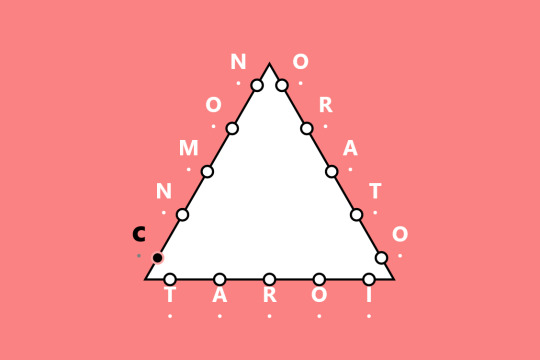
there was a short story murder mystery puzzle called the god of the labyrinth which was cool! i think this is a currently underexplored puzzle hunt genre, so i like seeing more of them, although it's always a time investment to read and digest one. this is accessible as a pdf here: https://www.flipbookpdf.net/web/files/uploads/f465b8d06c51eb130b2b8bfdd04181797ff97bb8202404.pdf
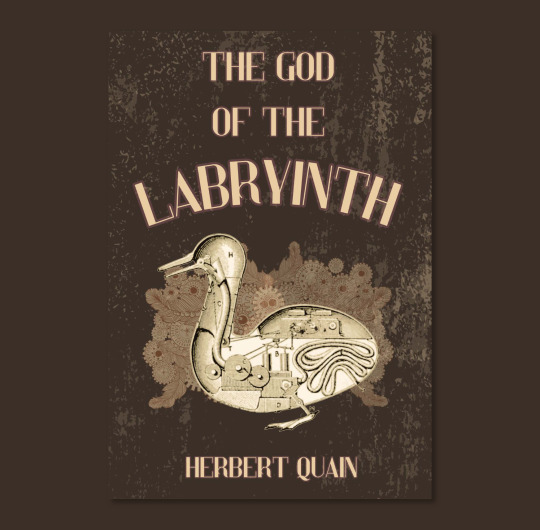
instagram was a pretty nice puzzle also, although it takes a keen eye (and having a working instagram account) to spot all of the relevant details on the page. the puzzle is entirely contained in this account page: https://www.instagram.com/ray.of.sunshine1997/

and the last one i'll mention is committing financial crimes, a konundrum where you fill out a really stupid irs form. as usual i willingly subjected myself to this and it was definitely cursed. the whole thing is accessible from this drive link: https://drive.google.com/file/d/1GRNNzrWRSzcuVzHmZsA_ZMD3gDlvGNZI/view i think they manually verified our solution to this?
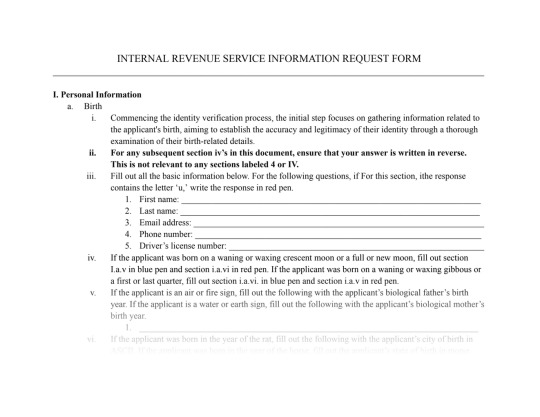
i had a lot of fun! super props to the puzzle club at brown university for putting this on. no rest for the weary though because cmu is next :)
(oh, and i also assume the data meta is actually quite cool - but we haven't finished it yet so i can't say for sure that it all holds up to scrutiny. here's hoping though)
4 notes
·
View notes
Text
Cyberchase on Pixter Console (part 1/?)
Hello all,
I wanted to talk about the Cyberchase game that was released for the Pixter handheld edutainment console during the early 2000s. To my knowledge, this is the only licensed console game released for the series. There were, of course, PC games released in the form of "Carnival Chaos" and "Castleblanca Quest". And they also had their various web-games.
Unfortunately, I don't own a copy of this game at this time. I can't really play through it on the real hardware and give my thoughts. I am aware that MAME has recently added a preliminary emulator for the Pixter console, and they did obtain the data from the cartridge. However, the emulation isn't yet sufficient to play the game.
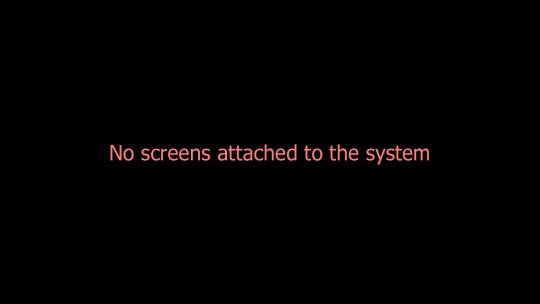
The purpose of this post is to document that this game exists, given its obscurity. There is also some material available to look at, like the manual. I hope that I can eventually provide screenshots, either by obtaining a cartridge, or waiting long enough for the MAME emulation to be ready.
I don't have a cartridge or box, but I found some photos. These images of the box-art and cartridge appeared on an eBay listing at one point.
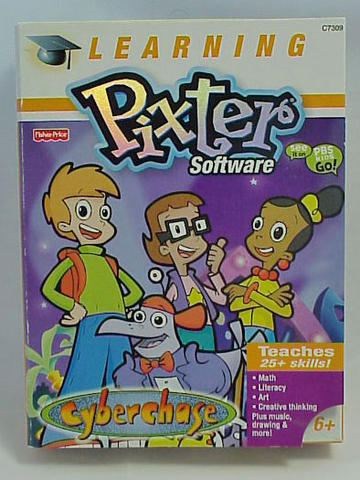
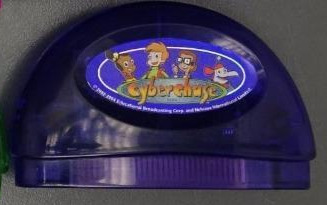
This console image appeared on a blog from Liz Herrick, one of the designers.
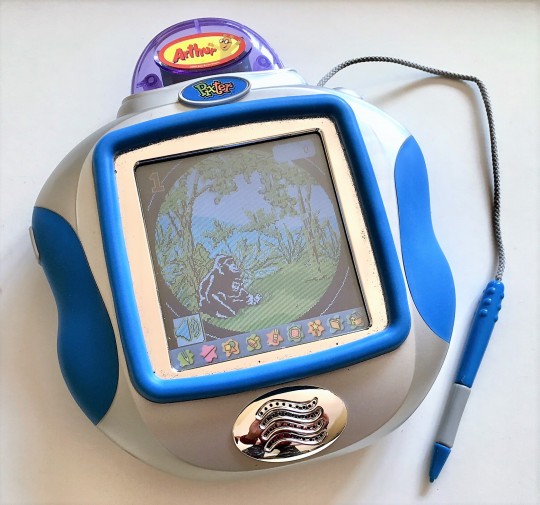
So, now that we've established that this thing exists, let's look at the manual for the Cyberchase game and see what we can figure out.
Here's a PDF download of the manual for those interested, but I'll post images of individual pages as I go.
So, the manual cover and box-art feature some classic Cyberchase artwork that got used for alot of stuff. We have Matt, Inez, Jackie, and Digit on hand. I'm not sure which Cybersite is in the background here, since the full-color version is so small, and the black-and-white version removes alot of context. My guess would be "R-Fair City".
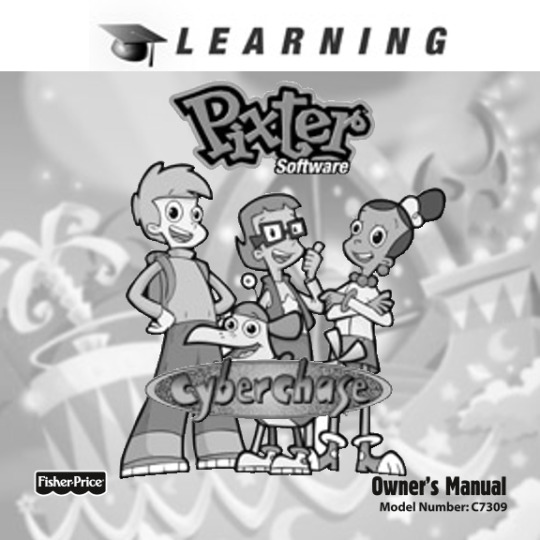
And now, we can see the standard instructions for logging in as your user.
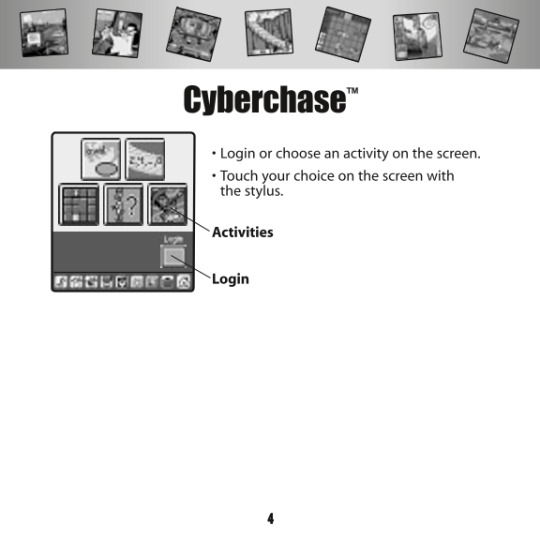
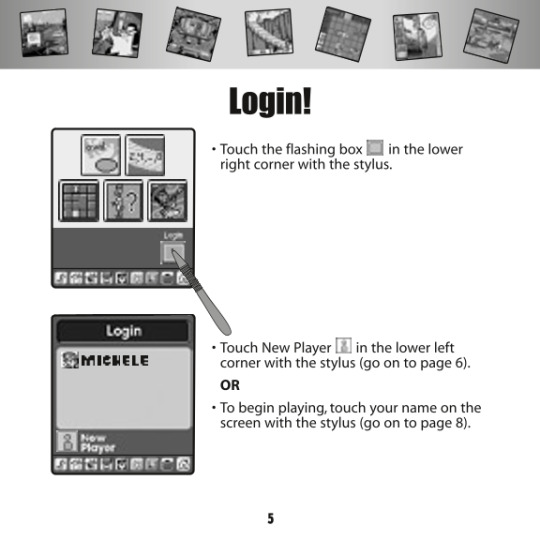
It's hard to see them due to the resolution of the scan, and perhaps Fisher-Price using bad screenshots to begin with. However, I can see Jackie (third row from the top and third column from the left) as one of the icons.

We get five games:
Sorting
Patterns
Logic
Creative Fun
Drawing
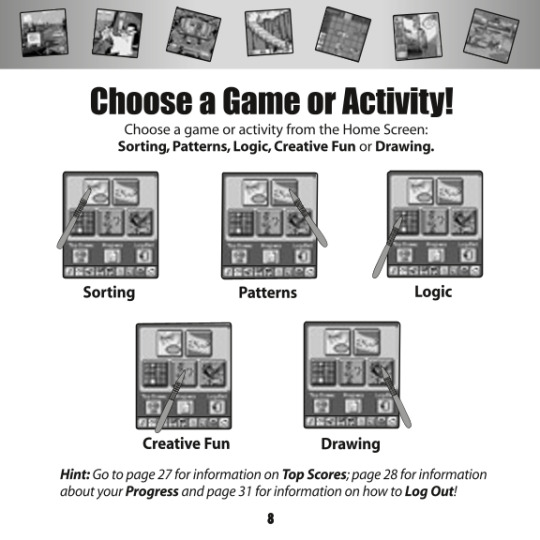
For "Sorting", we have Digit sorting Poddles by shapes, colors, both shapes and colors, or number comparisons. The screenshots are low-resolution, but it looks like we are sorting this poddle into one of two train cars, choosing between "hexagon" and "rectangle".
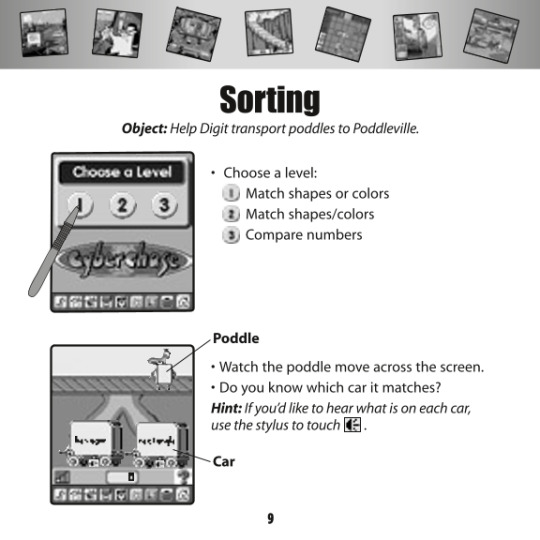
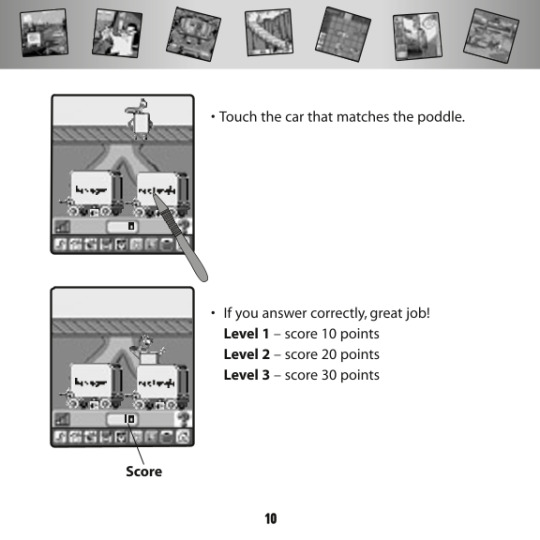
We can see the page that leads to the next level. I will say that the kids appear to have been badly cut out from something else.
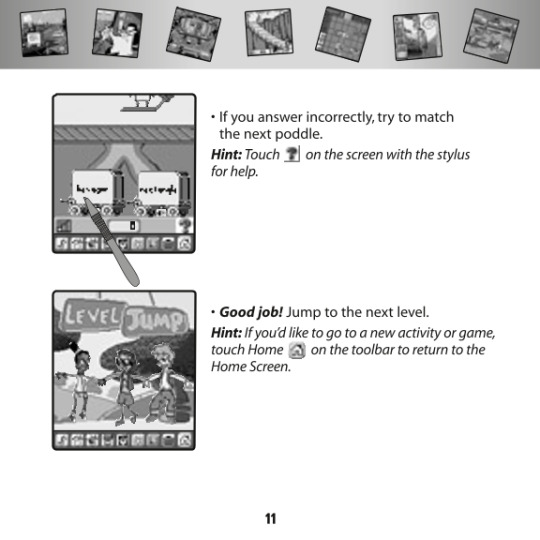
For "Pattern", we have a challenge to fit planks into a bridge based on patterns. We have an option for simple patterns, complex patterns, and number patterns. I don't recognize the character on the bridge.
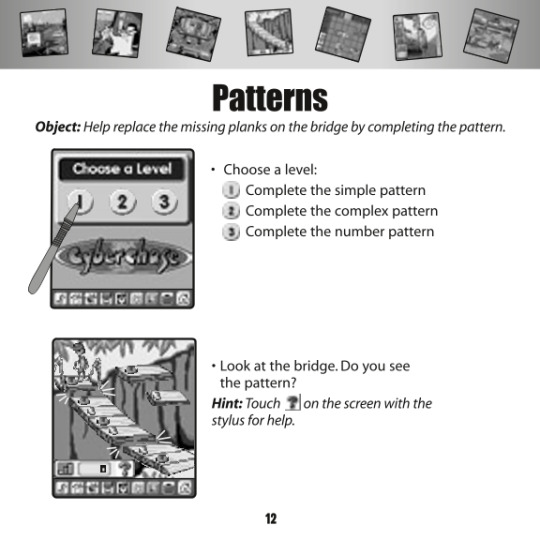
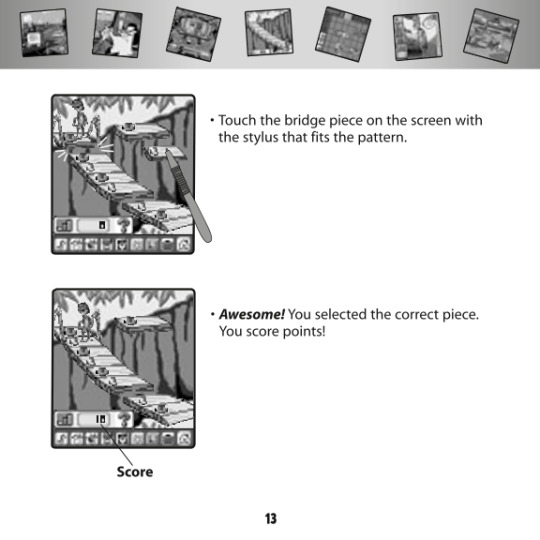
For "Logic", we have what appears to be a game of "Klotski". Klotski is a sliding block game where the goal is to get a single sliding block off the board by shifting other sliding blocks around to make room.
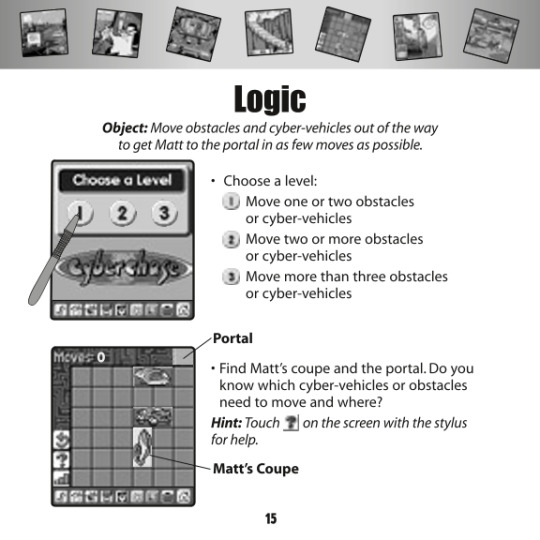
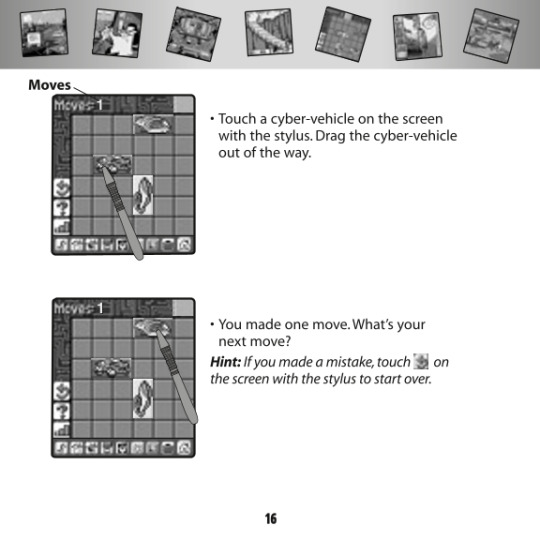
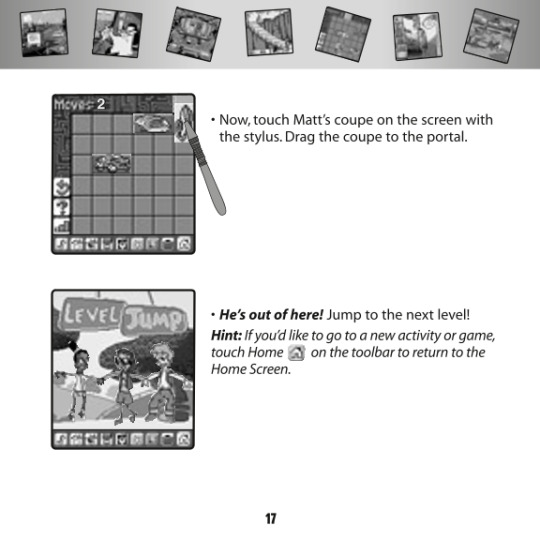
For "Creative Fun", we get to mix and match parts to create a "cyber-robot"? Is this a borg, a bot, or something else?
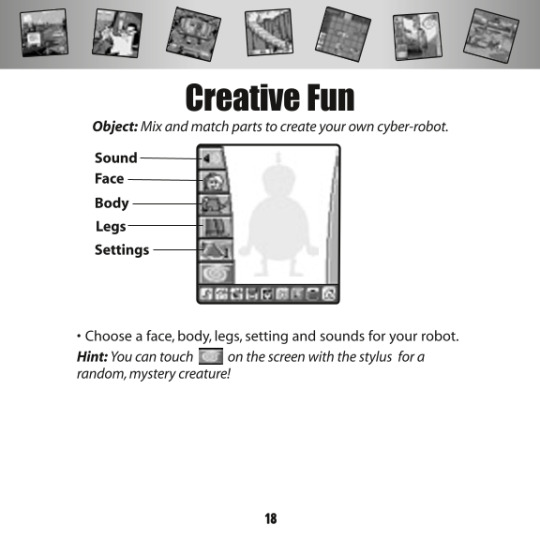
We can see some face options here.
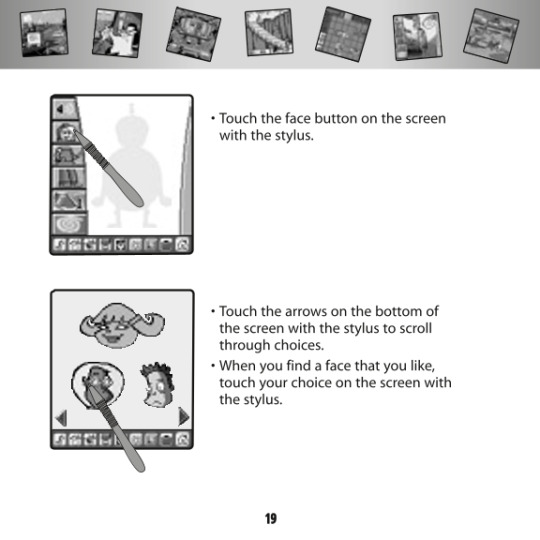
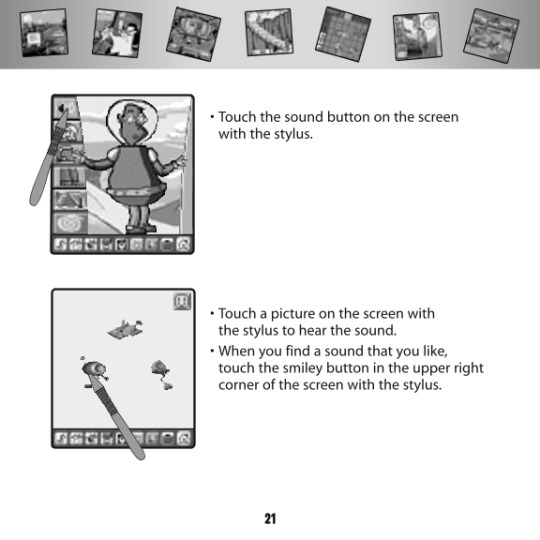
We also get to add the giant frog from "Eye of Rom" apparently.
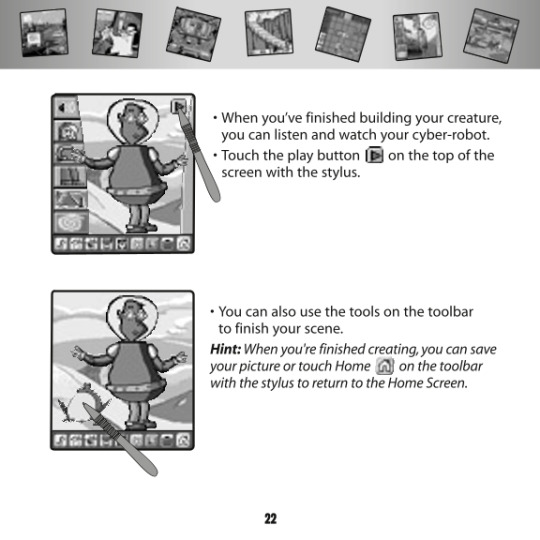
For "Drawing", we get to pick a background and use it to create a scene.
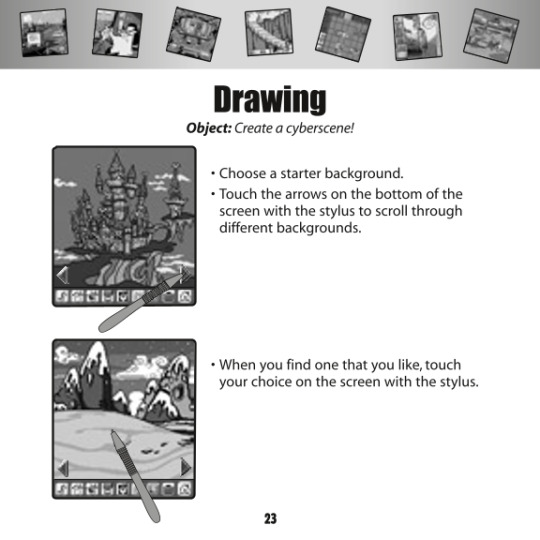
We can also put some stickers on it, like two classic pieces of Inez art.
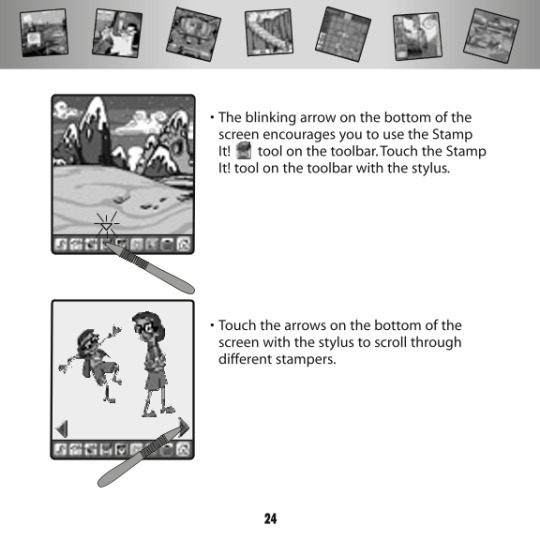
And here's some Delete stickers.
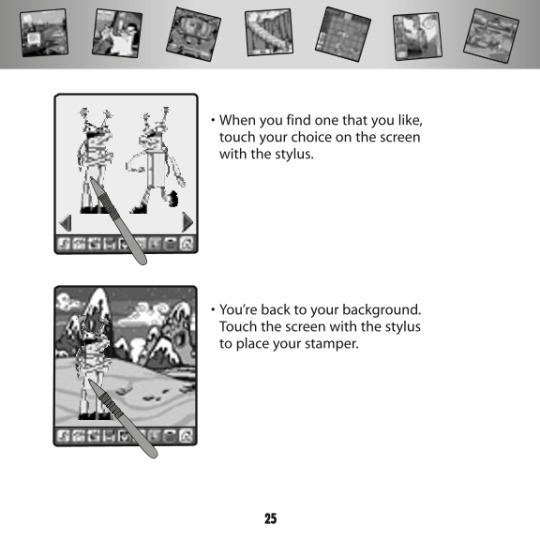
And here's a Digit sticker.

We can view high-scores for the activities.
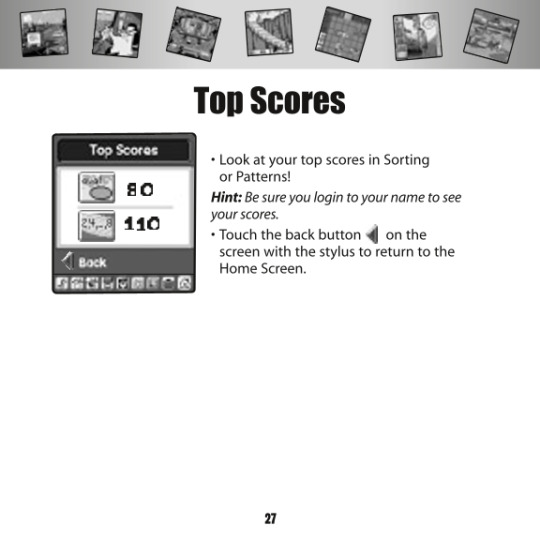
We can also check progress on these five activities.
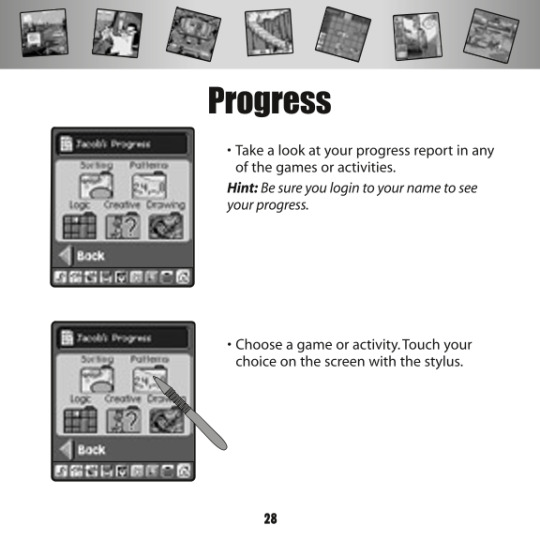
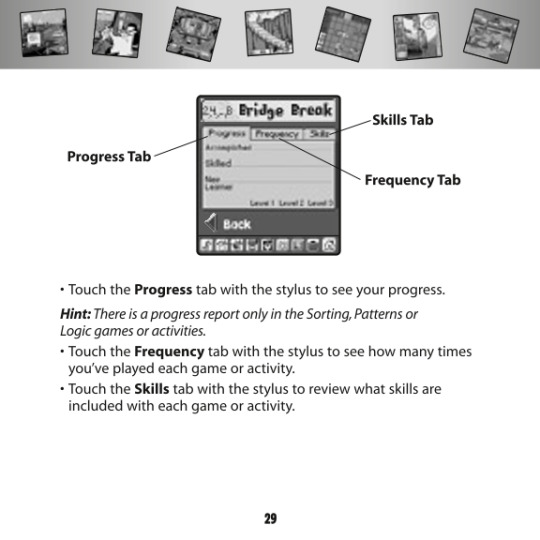
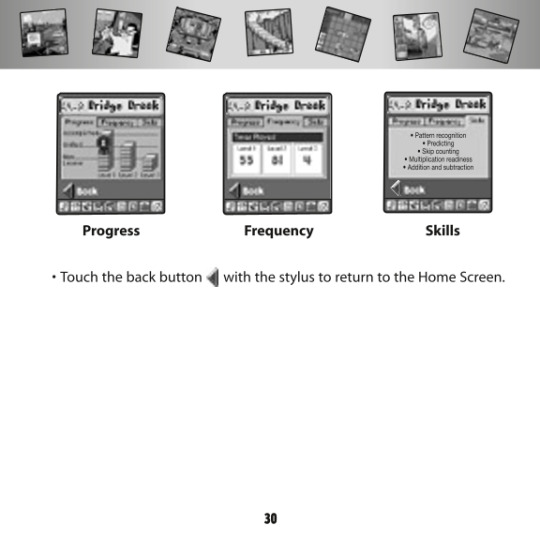
And then we log out and let someone else play, I guess.
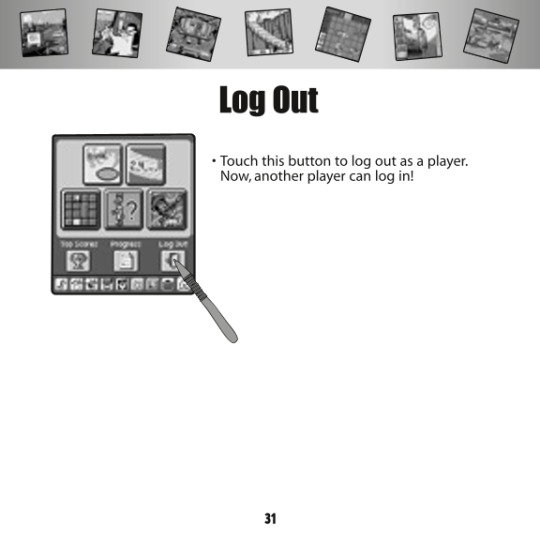
Yeah, I know this is pretty basic by today's standard. Someone in the intended age group for this probably would have enjoyed it though.
I wonder if this was distributed through FlyingMinds back in the day, who was responsible for alot of Cyberchase merch around 2005. Their site is gone, and several pages of content were missing. I suppose we'll have to wait until we get a good scan of the box to see if the FlyingMinds logo made it on there.
I hope to be able to share screenshots at some point, since this game is not well-documented online. Hopefully, I will either obtain a cartridge copy, or the Pixter emulation will improve.
5 notes
·
View notes
Text
Around dinner time one night in July, a student in Albuquerque, New Mexico, googled “suicide prevention hotline.” They were automatically blocked. The student tried again, using their Albuquerque Public Schools district–issued laptop to search for "contact methods for suicide." Blocked. They were turned away again a few hours later when attempting to access a webpage on the federally-funded Suicide Prevention Resource Center. More than a dozen times that night, the student tried to access online mental health resources, and the district's web filter blocked their requests for help every time.
In the following weeks, students and staff across Albuquerque tried and failed to reach crisis mental health resources on district computers. An eighth grader googled “suicide hotline” on their take-home laptop, a ninth grader looked up “suicide hotline number,” a high school counselor googled “who is a mandated reporter for suicide in New Mexico,” and another counselor at an elementary school tried to download a PDF of the district’s suicide prevention protocol. Blocked, blocked, blocked—all in a state with among the highest suicide rates in the US.
Thanks in large part to a two-decade-old federal anti-porn law, school districts across the US restrict what students see online using a patchwork of commercial web filters that block vast and often random swathes of the internet. Companies like GoGuardian and Blocksi—the two filters used in Albuquerque—govern students’ internet use in thousands of US school districts. As the national debate over school censorship focuses on controversial book-banning laws, a WIRED investigation reveals how these automated web filters can perpetuate dangerous censorship on an even greater scale.
WIRED requested internet censorship records from 17 public school districts around the US, painting a picture of the widespread digital censorship taking place across the country. Our investigation focuses on Albuquerque Public Schools (APS), one of the largest school districts in the US, which provided the most complete look at its web-filtering systems. APS shared 36 gigabytes of district network logs covering January 2022 to August 21, 2023, offering an unprecedented look at the kinds of content blocked by US schools on a daily basis. Our analysis of more than 117 million censorship records confirms what students and civil rights advocates have long warned: Web filters are preventing kids from finding critical information about their health, identity, and the subjects they’re studying in class.
“It’s just like another form of oppression,” Brooklynn Chavez, a senior at La Cueva High School in northeast Albuquerque, says of the district’s filters. “It’s like an awful kind of feeling.”
It’s a problem that’s not going away. This summer, APS installed Blocksi web filters on all student and staff devices. According to our analysis and interviews with APS staff, the results seemed to be disastrous. During the nearly three months APS used the Blocksi filter, it blocked more than a million network requests a day, on average, including searches for mental and physical health services; words related to LGBTQ+, Black, and Hispanic communities; websites for local youth groups; thousands of student searches for harmless information; and tens of thousands of news articles.
“It will basically shut down your internet,” Shellmarie Harris, director of educational technology at APS, says of Blocksi’s keyword filtering technology. “Kids, teachers will not be able to get into anything.”
APS, which installed Blocksi in May, stopped using the filter on most of its devices in August due to its restrictiveness, Harris says, and returned to the GoGuardian filter it used before the switch. Our investigation raises questions about the appropriateness and implementation of GoGuardian's filter as well.
In May, before the district switched to Blocksi, the GoGuardian filter blocked an eighth grader from searching for “suicide prevention.” It prevented a third grader from searching the word “latina” and a sixth grader from searching “black man.” When an 11th grader googled “Obergefell v. Hodges ruling,” instead of a list of websites with information about the landmark United States Supreme Court case that legalized same-sex marriage, the student saw a gray screen with APS’s logo and the message: “Restricted. This website has been blocked by your administrator.”
It is difficult to determine who exactly is responsible for a given content restriction. While APS administrators set the network policy for the entire district, individual teachers can also choose what to filter with GoGuardian—including whether to turn off the internet entirely for a particular student or class during a lesson, according to Harris. Outside of school hours, parents can also use the Blocksi and GoGuardian parent apps that APS provides to set their own restrictions on their kids’ school-issued devices.
Blocksi did not respond to multiple requests for comment or answer detailed questions about censorship of APS web activity.
Jeff Gordon, director of public relations for GoGuardian, tells WIRED, “GoGuardian regularly evaluates our website categorization to ensure, to the best of our ability, that legitimate educational sites are accessible to students by default.” He said more than 7,600 school districts use the company’s web filter and referred all questions about whether the blocked activity in Albuquerque was appropriately censored to the district.
Sithara Subramanian, an 11th grader at La Cueva High School, says she began to run into her school’s GoGuardian filter on a regular basis around the time remote learning ended. “It got kind of intense when we went back to school, like educational websites were being blocked,” Subramanian says. The censorship has been particularly frustrating for her biology and anatomy studies. “It felt like they were trying to restrict our education rather than enhance it.”
“My son says the filters make the internet useless,” Sarah Hooten, the mother of Henry, a 13-year-old former APS student, tells WIRED. Henry says that he couldn’t use YouTube to look up information for a report he was assigned about rainforests. “I know it’s partly to do with blocking kids from doing what they aren’t supposed to be doing,” Henry says. “But it’s also just the school not understanding what they are blocking.”
What Went Wrong
The scale of censorship we found in Albuquerque’s schools shows how web filters can twist seemingly simple decisions to block unwanted online content into policies that render the internet near impossible to use.
In one instance, an APS staff member was unable to view The New York Times’ Pulitzer Prize–winning 1619 Project, a historical exploration of slavery and its consequences in the United States, because of an apparently misguided keyword block in the district’s Blocksi filter. The district’s web-filter blocked websites containing the keyword “avery.” This blocked hundreds of attempts to access the website of a printing company, Avery.com, although APS officials could not explain why “avery” was keyword-blocked. But because the URL for the 1619 Project includes the word “slavery,” it was also blocked. So was a Stanford University lecture about slavery, a Wikipedia map of slavery in the United States, and several articles about a controversial Florida curriculum about slavery.
APS records show that keywords on the district blacklist triggered the Blocksi filter nearly 32 million times from May 31 through August 21.
While most of the keywords WIRED reviewed are meant to restrict pornographic content and games, some appear to have unintentionally caused broader restrictions that prevented students from accessing legitimate educational content. A ban on the word “assault,” for example, blocked news articles at least 60 times, including stories from The Atlantic, CNN, and the Associated Press. In total, APS blocked students accessing news websites nearly 40,000 times.
“It’s not the right approach to try and censor information because we are afraid of how they are going to react to it,” Caitlin Vogus, deputy director of advocacy at the Freedom of the Press foundation, tells WIRED. “If anyone in our society has a stake in reading about school shootings, it’s the students themselves.”
The banned keywords also show that someone—APS could not say who—blocked access to critical health websites. For example, the websites of the US Centers for Disease Control and Prevention (CDC) and Planned Parenthood were keyword blocked. CDC web pages, including many specifically pertaining to Covid-19, were censored as many as 1,607 times. Planned Parenthood pages were censored more than 50 times in Albuquerque while Blocksi was in use.
APS communications director Monica Armenta tells WIRED that, “to the best of my knowledge,” the district didn’t purposefully block URLs containing “avery” or the websites of the CDC and Planned Parenthood.
“We regularly referred our families and staff to the CDC for guidance on Covid,” Armenta says. “We did not find any issues with students or staff accessing CDC, Planned Parenthood, or ‘avery’ during school hours.” At the time of Armenta’s response, the district was no longer using the Blocksi filter that restricted those websites.
Nearly three-quarters of the blocked activity WIRED examined was not explicitly tied to a keyword, and the data APS provided did not explain why those web pages triggered the district’s filters.
Blocksi says it sorts content into 79 preset categories to make its blocking decisions. Those categories include “alternative beliefs,” “abortion,” “sex education,” “folklore,” and “meaningless content.” School staff can choose which of those categories to block, allow, or block with a warning.
GoGuardian says it uses machine learning algorithms that scan the content and context of a page, rather than just pick out keywords, to decide whether it’s appropriate for students. But WIRED’s analysis of censorship logs from APS raises questions about the effectiveness of GoGuardian’s filter at judging context. For example, between January and August of 2023, the district’s GoGuardian filter blocked more than 1,580 websites with the word “gay” in the URL. While that included domains and URLs that contained sexual content, many did not appear to have any sexual content at all. On May 18, the district’s GoGuardian filter blocked a La Cueva High School 10th grader’s one-word Google search for “gay.”
Harris, Albuquerque’s educational technology director, says the word “gay” shouldn’t have been blocked on its own but might have triggered another rule in the filter. After googling “gay” on her own computer, she speculated that GoGuardian might have blocked the search because the results page includes Google Maps listings for several bars in Albuquerque that cater to LGBTQ+ customers, and the district has chosen to block content related to alcohol on its devices.
GoGuardian’s filter can trigger automatic alerts to school staff about browsing activity. During an interview with WIRED, Harris received a GoGuardian Smart Alert notifying her that a student was looking at potentially dangerous material online. “This poor child is getting targeted because [they searched] ‘how to draw grass,’” Harris says. “And so it’s probably thinking ‘grass’ is marijuana.”
Harris says APS allows staff and students to request that content be unblocked. Several of the students who spoke to WIRED say they wouldn't feel comfortable asking administrators to unblock content.
Tiera Tanksley, a research fellow who studies youth and technology policy at UCLA, tells WIRED that schools need to consider the consequences of over-filtering, especially when technology like GoGuardian’s Smart Alerts automatically notifies adults about what kids are looking at online.
“We have to remember who’s using school-issued devices,” Tanksley says. “It’s already baked in that these are going to be lower income, probably people of color, just because of the economic disparities. Getting flagged multiple times trying to access inappropriate content is opening the door for other types of disciplinary disparities,” she argues.
During the 2022-2023 school year, 66 percent of APS students identified as Hispanic, 20 percent as white, 5 percent as American Indian or Alaskan native, and 3 percent as Black, according to data published by the school district. Nearly 68 percent of the district’s students received free school meals, which is a rough reflection of how many families live near the poverty line and slightly higher than the national average.
Our investigation found that both the Blocksi and GoGuardian filters used by APS censored a wide range of words, websites, and online resources related directly to race and ethnicity. And students who spoke to WIRED say they were frequently blocked while attempting to research historical events that involved racism or violence.
When a 12th grader at the city’s Atrisco Heritage Academy High School tried to ask Google for information about “structural racism black community,” GoGuardian blocked their search, records reviewed by WIRED show. It also nixed a ninth grader’s search for illustrations of Black people, a seventh grader’s search for “pueblo indians,” a fourth grader’s image search for “immigrant,” and a ninth grader’s image search for “el mobimiento [sic] chicano”—the Mexican-American Chicano Movement of the 1960s.
Blocksi’s filters blocked similar search terms, including “how oppressed are black people.” And it blocked hundreds of attempts to access legal information for immigrants at USCIS.gov. On July 27, it prevented an APS staff member from opening the form used to apply for US citizenship online, APS records show.
Chavez, the La Cueva High School senior who leads their school’s Native American Student Union, says the district’s filters have hindered their attempts to research Indigenous heritage and Indigenous protests. ”Because I can’t find information on certain Indigenous topics, I’m wondering about kids who are younger than me, Indigenous kids who are trying to look up their heritage, trying to learn about their heritage,” Chavez says. “It frustrates me because they can’t. It’s not easily accessible, especially during school hours.”
Content related to gender, sexuality, and identity was also blocked across Albuquerque. For instance, the district's web filters prevented six students from visiting pages at the Trevor Project, one of the nation’s leading LGBTQ+ youth advocacy groups. Even the websites of local youth nonprofits, including Together for Brothers and the Southwest Organizing Project, were restricted. Three different middle schoolers, on three different days, searched for “pride flag” and were blocked.
In a statement to WIRED, Casey Pick, director of law & policy for the Trevor Project, characterized APS’s censorship as “dangerous” and “unethical.”
“Blocking content inherently suggests that it’s something that is inappropriate or that people shouldn’t see or know about,” says Josh Block, a senior staff attorney at the American Civil Liberties Union (ACLU) who focuses on the civil-liberties-focused nonprofit’s LGBT and HIV Project. “That certainly has a message that reverberates beyond just the computer screen.”
Gordon, the GoGuardian spokesperson, says the company “does not block searches or restrict access to legitimate educational sites by default, nor do we block LGBTQIA+, reproductive health, or racial justice websites by default.”
Web pages belonging to the ACLU were blocked 68 times.
Safety vs. Education
The consequences of school web filtering reach far beyond Albuquerque. Virtually every school in the US uses an automatic web filter, largely due to the Children’s Internet Protection Act (CIPA) passed by Congress in 2000. The law requires schools and libraries to block “child pornography” and other content deemed “obscene” or “harmful to minors” in order to be eligible for federal technology aid known as E-rate funding.
In districts like Albuquerque’s, which invested millions to provide take-home computers to students, the filters have increasingly come to govern kids’ online lives both inside and outside of school. Our investigation found that nearly 10 percent of the blocks between January 2022 and August 2023 occurred on weekends.
The filters catch plenty of content that district officials say should legitimately be blocked—some students try to look at porn, many try to play online games during school, and a significant portion of the content blocked by Albuquerque’s filters appears to be pop-ups, advertisements, and spam. Harris says the district has intentionally chosen to block students from accessing generative AI tools; during the three months it was in place, Blocksi prevented more than 41,000 attempts to access ChatGPT.
“There are hundreds of thousands of sites that are being created every day that we don't have the resources to vet and look at all the time,” Harris says. “We do the best with our resources and our stance really is to limit the amount of filtering and teach digital citizenship.”
Since CIPA was first proposed in 1998, critics and supporters alike have raised concerns about the impact of web-filtering technology and the balance between free access to information and safety.
“I am very concerned about censorship,” the law’s primary sponsor, late Arizona Senator John McCain, told The New York Times in February 1998. “But I think we need to act to try and provide some rules, otherwise we may find ourselves in a situation where Americans say, ‘Look, this has got to stop; we are willing to sacrifice some of our civil liberties to protect our children.’”
When it was passed in 2000, CIPA was immediately challenged by the American Library Association and the ACLU, which argued in a series of lawsuits that that the law’s web-filtering requirement placed unconstitutional restrictions on library patrons’ speech. In 2003, the US Supreme Court voted 6 to 3 that government-mandated web filtering was constitutional, in part because libraries allowed patrons to request that specific websites be unblocked.
Students and civil rights groups have continued to fight against web censorship. In 2011, the ACLU launched a “Don’t Filter Me” campaign that encouraged schools to stop using web filters that blocked LGBTQ+ content. The campaign culminated in a 2012 case in which a federal court ordered the school district in Camdenton, Missouri, to stop using a filter that explicitly blocked non-adult LGBTQ+ websites.
In the decade since that ruling, students have consistently complained about school web filters’ allegedly discriminatory blocking patterns. A student in Hawaii claimed his school’s Securly web filter was labeling sites that had “gay” in the domain as pornography. In Park City, Utah, students complained that they were allegedly prevented from searching for words including “gay,” “lesbian,” and “queer.” And in Katy, Texas, student protests and an ACLU complaint last year forced the school district to stop using a web filter with a category that the complaint said had been titled “Alternative Sexual Lifestyles (GLBT) Global” and blocked access to the Trevor Project and other LGBTQ+ support organizations’ websites.
Victories against inaccurate and potentially dangerous web filters are rare. In September, a nationwide survey conducted by the Center for Democracy and Technology found that a majority of students believe their school’s web filter hinders their ability to do schoolwork. In schools with web filters, 71 percent of students agreed that it was sometimes hard to complete school assignments because web filters were blocking access to essential information. The same percentage of students said they’d been blocked from visiting websites they felt they should have been allowed to visit. And LGBTQ+ students reported being blocked from content at higher rates than non-LGBTQ+ students on both questions.
More than half of the teachers who responded to CDT’s survey (57 percent) agreed that their school’s web filters made completing assignments harder. Thirty-seven percent of teachers believed their school’s web filters were more likely to block content associated with LGBTQ+ students, and 32 percent believed the filters were more likely to block content associated with students of color.
Chavez, the senior at La Cueva High School in northeast Albuquerque, says they and many other students at their high school have stopped using their APS-purchased Chromebooks altogether. Instead, they say, students now bring their personal laptops from home to school. But other students say they don’t have that option.
“It totally inhibits me from doing proper research or slows down my whole workflow,” Mateo, a senior at another APS high school who asked that we not use his real name, says of the district’s filters. But his school won’t allow students to bring personal laptops, meaning he has no choice but to use the filtered internet.
“I think it’s kind of redundant and almost offensive,” Mateo says, “that they would try to censor everything to such an obscene degree.”
5 notes
·
View notes